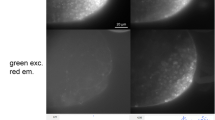Abstract
A novel fluorescence procedure has been used to study the binding characteristics of DNA with three modern fluorochromes currently used in chromosome cytochemistry. The transient changes in the polarised components of fluorescence have been recorded for dye-tagged DNA solutions when subjected to short duration electric pulses. From these data, it has been inferred that, like ethidium bromide, berberine sulphate and quinacrine mustard both intercalate the DNA structure whilst the bi-benzimidazole derivative Hoechst 33258 binds with a distinctively different geometry, probably within the helical grooves.
Similar content being viewed by others
References
Caspersson T, Zech L (eds) (1973) Chromosome identification — techniques and applications in biology and medicine. Nobel Symposium 23, Academic Press, New York
Caspersson T, Zech L, Modest EJ, Foley GE, Wagh W, Simonsson E (1969) Chemical differentiation with fluorescent alkylating agents in vica fabia metaphase chromosomes. Exp Cell Res 58: 128–140
Caspersson T, Lomakka G, Zech L (1971) The 24 fluorescence patterns of the human metaphase chromosomes — distinguishing characters and variability. Hereditas 67: 89–102
Comings DE (1975) Mechanism of chromosome banding. VIII. Hoechst 33258-DNA interaction. Chromosoma 52: 229–243
Fredericq E, Moussier C (1973) Electric dichroism and electric birefringence. Oxford University Press, London
Hecht F, Wyandt HE, Magenis REH (1974) The human cell nucleus: quinacrine and other differential stains in the study of chromatin and chromosomes. Busch H (ed) The cell nucleus. Academic Press, New York, pp 33–121
Hilwig I, Gropp A (1972) Staining of constitutive heterochromatin in mammalian chromosomes with a new fluorochrome. Exp Cell Res 75: 122–126
Hogan M, Dattagupta N, Crothers DM (1979) Transient electric dichroism studies of the structure of the DNA complex with intercalated drugs. Biochemistry 18: 280–288
Jennings BR, Ridler PJ (1977) Electrically induced fluorescence depolarisation of macromolecules. Chem Phys Lett 45: 550–555
Latt SA (1973) Microfluorometric detection of deoxyribonucleic acid replication in human metaphase chromosomes. Proc Natl Acad Sci USA 70: 3395–3399
Le Pecq JB, Paoletti C (1967) A fluorescent complex between ethidium bromide and nucleic acids. J Mol Biol 27: 87–106
Moutschen J (1976) Fine structure of chromosomes as revealed by fluorescence analysis. Prog Biophys Mol Biol 31: 39–66
Moutschen J, Degraeve N, Moutschen-Dahmen M (1973) Chromosome fluorescence with berberine. Cytobiologie 8: 112–117
Ridler PJ, Jennings BR (1978) Electrically induced fluorescence changes from solutions of dye tagged polyribonucleotides. In: Jennings BR (ed) Electro-Optics and dielectrics of macromolecules and colloids. Plenum Press, New York, pp 99–107
Ridler PJ, Jennings BR (1980) Polarised fluorescence studies of electrically oriented DNA-dye solutions. Int J Biol Macromol 2: 313–317
Ridler PJ, Jennings BR (1982a) Eleectrically induced fluorescence as a method for studying benzo(a)pyrene binding to DNA. FEBS Lett 139: 101–104
Ridler PJ, Jennings BR (1982b) Electro-optical fluorescence for characterising molecules of medical importance. In: Jerrard HG (eds) Electro-optics/Laser international 1982 conference proceedings. Butterworth Scientific, London, pp 258–264
Weisblum B, Haseth PL de (1972) Quinacrine, a chromosome stain specific for deoxyadenylate-deoxythymidylate-rich regions in DNA. Proc Natl Acad SCI USA 69: 629–632
Weisblum B, Haenssler E (1974) Fluorimetric properties of the bibenzimidazole derivative Hoechst 33258, a fluorescent probe specific for AT concentration in chromosomal DNA. Chromosoma 46: 255–260
Author information
Authors and Affiliations
Rights and permissions
About this article
Cite this article
Jennings, B.R., Ridler, P.J. Interaction of chromosomal stains with DNA. Biophys. Struct. Mechanism 10, 71–79 (1983). https://doi.org/10.1007/BF00535543
Received:
Accepted:
Issue Date:
DOI: https://doi.org/10.1007/BF00535543




